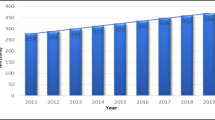Abstract
Waste of polystyrene was converted into a cation exchange resin and was used for the removal of lead and cadmium metals from aqueous solution. Wastes consisting of coffee cups were crushed into small pieces and immersed into a solution of sulfuric acid in order to attach sulfonic group to polymer chain, these groups are responsible for the exchange properties of the modified plastic. The cation exchange capacity (CEC) was determined and was comparable to commercial exchangers. The adsorption isotherms of resin with synthetic wastewater containing lead and cadmium ions were tested. Adsorption analysis results obtained at various concentrations showed that the adsorption pattern on the resin followed Langmuir isotherms.







Similar content being viewed by others
References
Kiesche ES (1990) Chem Week 147:42
Claerbout J (1987) Conserv Recy 10:185
Woo OS, Ayala N, Broadbelt LJ (2000) Catal Today 55:161
Kaminsky W, Predel M, Sadiki A (2004) Polym Degrad Stabil 85:1045
Miskolczia N (2004) Polym Degrad Stabil 86:357
Yeon KH, Song JH, MoonKyeong-Ho SH, Seung-Hyeon M (2004) Water Res 38:1911
Szczepaniak W, Siepak J (1973) Chem Anal 18:1019
Szczepaniak W (1974) Chem Anal 19:869
Demirbas A, Pehlivan E, Gode F, Gulsin TA (2005) J Colloid Interface Sci 282:20
Dabrowski A, Hubicki Z, Podko-Scielny P, Robens E (2004) Chemosphere 56:91
Erdem E, Karapinar N, Donat R (2004) J Colloid Interface Sci 280:309
Palma G, Freer J, Baeza J (2003) Water Res 37:4974
Bajdur W, Pajączkowska J, Makarucha B, Sulkowska A, Sulkowski W (2002) Eur Poly J 38:299
Inagaki Y, Kuromiya M, Noguchi T, Watanable H (1999) Langmiur 15:4171
Theodoropoulos AG, Valkanas GN, Stergiou DH, Vlysidis AG (1994) Macromol Rep 31:9
Simitz J, Fountas D (1995) J Appl Poly Sci 55:879
Caretta N, Tricoli V, Picchioni F (2000) J Mem Sci 166:189
Kučera F, Jančař J (1996) Chem Papers 50(4):224
Kučera F, Jančař J (1998) Polym Eng Sci 38(5):783
Baig D, Seery T, Williams CE (2002) Macromolecules 35:2318
Li HM, Liu JC, Zhu FM, Lin SA (2001) Polym Int 4:421
Pitcher SK, Slade RCT, Ward NI (2004) Sci Total Environ 334:161
Erdem E, Karapinar N, Donat R (2004) J Colloid Interface Sci 280:309
Taty-Costodes VC, Fauduet H, Porte C, Delacroix A (2003) J Hazard Mater B105:121
Alguacil FJ, Alonso M, Lozano LJ (2004) Chemosphere 57:789
Bekri-Abbes I, Bayoudh S, Baklouti M (2006) Prog Rubber, Plastics Recycling Technol 22:179
Martins CR, Ruggeri G, De Paoli MA (2003) J Braz Chem Soc 14:797
Acknowledgment
A part of this work has been done in the department of material in “L‘Institut National de la Recherche Scientifique et Technique”, I would like to thank especially Dr. Srasra Ezzedine for its considerable help.
Author information
Authors and Affiliations
Corresponding author
Rights and permissions
About this article
Cite this article
Bekri-Abbes, I., Bayoudh, S. & Baklouti, M. Converting Waste Polystyrene into Adsorbent: Potential Use in the Removal of Lead and Cadmium Ions from Aqueous Solution. J Polym Environ 14, 249–256 (2006). https://doi.org/10.1007/s10924-006-0018-3
Published:
Issue Date:
DOI: https://doi.org/10.1007/s10924-006-0018-3




